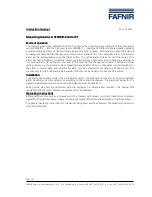
FM30
•
34
In all cases, the field strength of a signal decreases in direct proportion to the
distance away from the antenna. Power decreases by the square of distance:
for every doubling in distance, the signal power is quartered, but the field
strength voltage is only halved. Using this theory, we can construct a simple
chart to show the maximum permitted performance of a non-licensed FM band
transmitter. The theoretical figures assume a simple 1 meter receiving an-
tenna in all cases and do not take into consideration that reception can be
greatly enhanced with larger, multi-element antennas and preamplifiers. In the
following chart, the field strength (theoretical minimum) gets even stronger as
you move from the edge of these circular boundaries toward the antenna:
This "exercise in meters and microvolts" demonstrates that the FCC clearly
intends to limit the theoretical range of non-licensed devices operating in this
band. It also shows the potential for causing interference at a home down the
street from you. But it also shows that you can legally put out quite a good
signal over wider areas than you might have imagined.
For other kinds of radio services, the FCC restricts such factors as transmitter
power or antenna height, which cannot really limit the possible "range" of a
transmission under good conditions. By restricting the maximum field strength
at a specific distance from your antenna, the FCC clearly plans for your signal
to "die out" at a specific distance from your antenna, no matter what kind of
transmitter power or extra-gain antenna you are using. On the other hand, the
FCC standards do make it legal and possible for you to broadcast on a school
campus, campground or local neighborhood, as long as you do not cause in-
terference to broadcast reception.
“Why talk about acres"?
There are three reasons to translate our look at "field strength" into "acres".
1. The first one is easy: the numbers would get too cumbersome if we dis-
cussed your possible signal coverage in terms of square feet or square
meters.
2. It's very easy to see that your signal can easily and legally serve a school
campus or wilderness campground.
3. And, if we remember that typical urban single-family home sites run from
1/4 to 1/2 acre on the average, it should become extremely clear that your
obligation to avoid interfering with broadcast reception can easily involve
hundreds of homes, before adding apartments!
In fact, the most significant distance in the above chart is the 1.9 µV signal
strength permissible at 1260 feet (about 1/4 mile), covering a circular area of
about 114 acres. A quick glance at stereo FM receiver specifications shows
typical sensitivity of 1.7 µV before considering high-gain antennas or preampli-
fiers. Your non-licensed signal can provide serious competition to a public







































